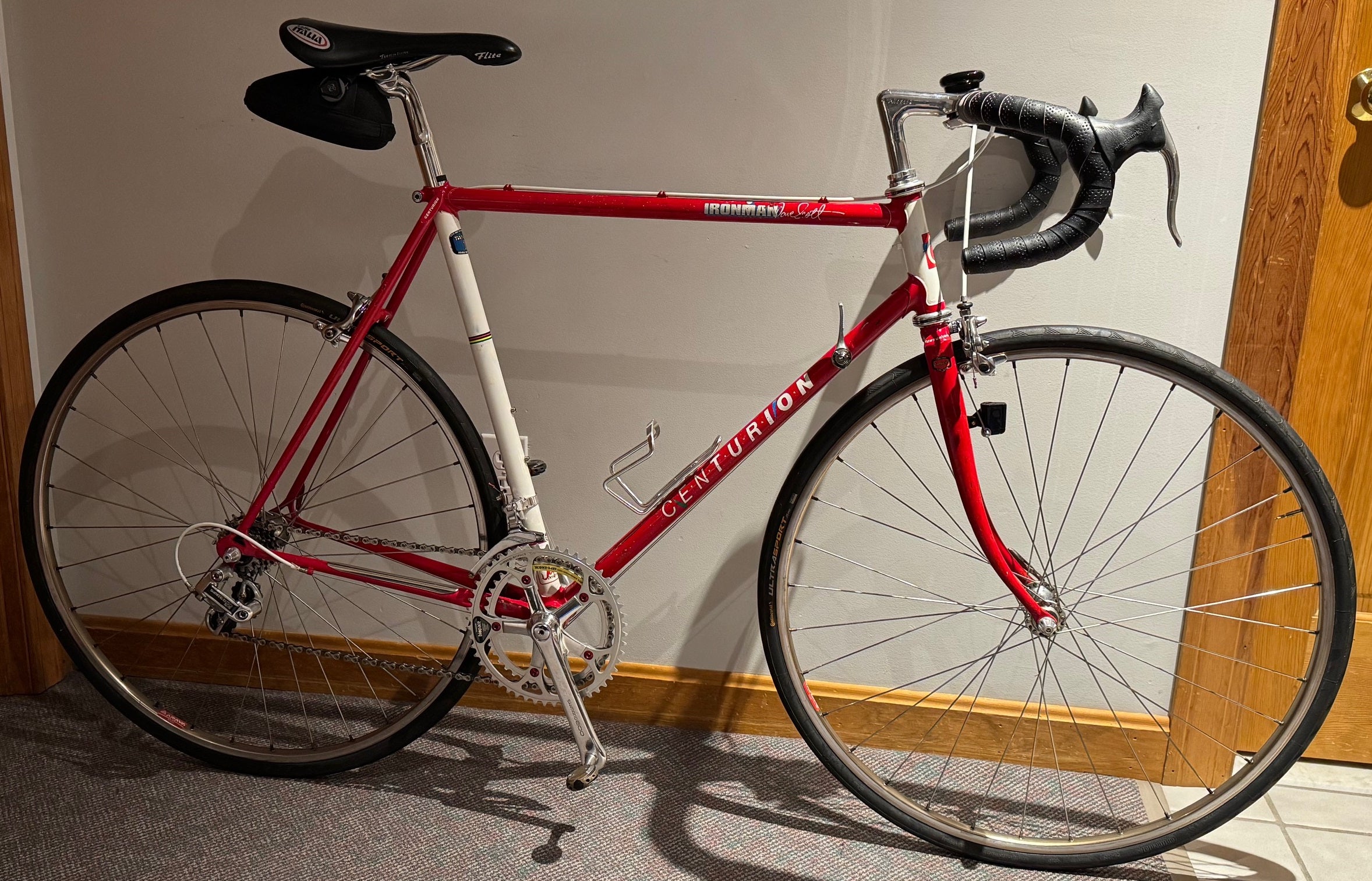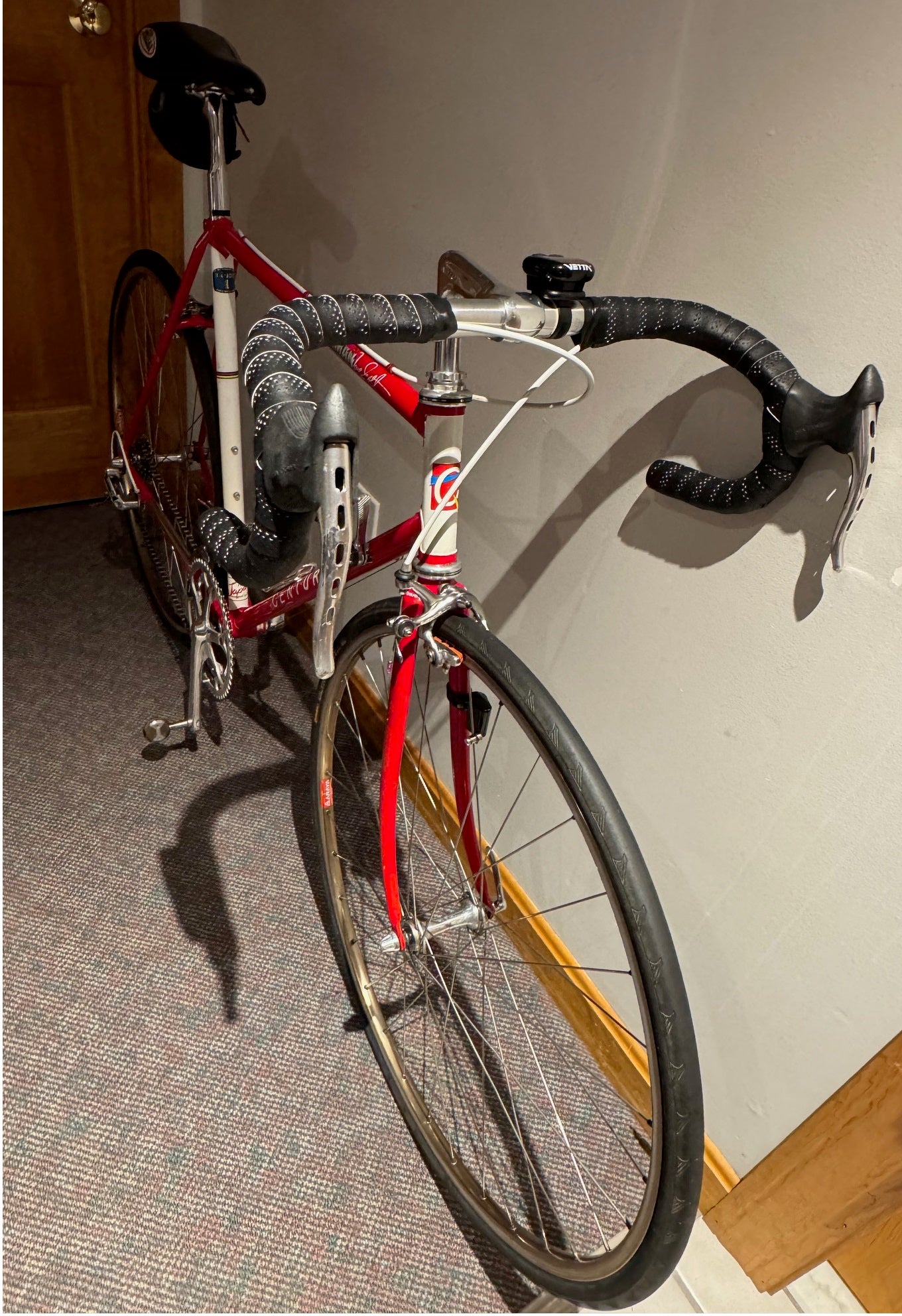Because Red Bikes Are Faster...

When I first started cycling as an adult, I trained almost exclusively alone, only occasionally going for longer rides with friends. My performance in that group made me think I was in pretty good shape, especially for a 40-year-old (1996), so I decided to challenge myself by going to Union Cycle in Attleboro and joining their Saturday morning ride, a competitive 55-miler.
On my very first ride, I found out that, although I was in good shape for me, I wasn't in good enough shape to compete with them. There were several pros and some outstanding amateurs in the ride, and after falling off the back and almost getting dropped, I knew I had some work to do.
Over the next couple of weeks, I trained hard on local roads. I did hills and sprints—the two weaknesses that were exposed during that ride. When I returned to Attleboro two weeks later, I was ready to be more competitive. I still lacked the climbing and sprinting expertise of some of the others, but overall, I was a very strong rider.
It was after a hill climb, when most riders ease up and recover, that I put the hammer down. No one was expecting it, and when I did a solo breakaway, the peloton responded. I heard someone ask, "Who's that?"
I was off the front and tucked on my mini aero bars—the ones deemed legal in the Tour de France for a short time—determined to hold 23 mph for as long as I could.
It wasn't long before the pack caught me, but no one challenged; they formed a single line behind me. I didn't turn around to look, but I could hear them breathing.
During a group ride, when the peloton line forms, each rider takes the lead position for 30 seconds, maintains speed, and then pulls off to the left, drifting back to the end of the line, while the next rider in line takes the next 30-second pull. It keeps repeating until some riders start to get dropped. It can be ridden at a grueling pace, and not everyone can keep up.
During this breakaway, I held the lead position for seven minutes, and when I saw my speed start to drop, I pulled off to the left. As riders passed me, each one said. "Nice pull." That was the moment I became a member of the Union Velo Cycling Club.
I rode with them every Saturday that summer and into the fall, and I got to meet a lot of very cool cyclists who were into it as much as I was. I discovered that the bike shop in Attleboro wasn't just a bike shop; it was a place for cyclists to gather and talk about cycling, or any other subject they wanted.
It came at a time when Lance Armstrong was wearing the yellow jersey, winning the Tour de France every year, created Livestrong, and had become a national hero. The cheating scandal hadn't surfaced yet. Notice the difference in the levers. Lance preferred a downtube shifter for changing front chainrings. He said the down tube shifters were lighter, more accurate, and less likely to drop a chain than their STI counterparts…
 Tim de Waele. Getty Images.
Tim de Waele. Getty Images.I was in awe. I had become a member of the cycling community in Attleboro. It was a great time in my life. I had never been healthier, and Susan was years away from being diagnosed. Life was good!
I was impressed with all the exotic bikes and all the different colored kits (cycling clothing) everyone was wearing. I upped my clothing game a little to fit in. I even shaved my legs like the other cyclists, not wanting to stand out or look like a bear. I continued riding my 1988 Schwinn Premis. Ron, the head mechanic at Union Cycle, installed hand-built wheels and high-end components on the bike that kept me competitive.
By late fall, I began to notice riders showing up with different bikes, older ones that displayed some wear and tear. I wasn't sure what was going on. Where were all those exotic bikes I drooled over all summer? These bikes reminded me of the ugly sweaters worn at Christmas parties, mismatched parts and all…
I asked Rick, the owner of Union Cycle, what was going on. He said that when the weather got cold and there was a chance foul weather could create hazardous road conditions, people started getting out their "beater bikes", which he said were dispensable, unlike the high-end bikes they rode during the summer months. Some riders used these bikes in the early part of the following season, until the street cleaners picked up all the sand and salt still covering the roads from the harsh winters here in Massachusetts. On one early-season ride, I saw a guy take a corner in sand and crash his brand-new Cannondale, the newer tires being even more slippery.
I actually enjoyed seeing everyone's beater bikes even more than seeing their high-end racing bikes. Most of the beaters were once racers, and hard miles, age, and, in some cases, crashes put them into the beater bike category. But make no mistake, each one has smooth-operating components and decent training wheels that run true. The beaters are all dialed in to fit their respective riders as well. Very few concessions are made, aside from the use of older frames, winter wheels, and heavily used components.
That first year, I didn't have a beater bike. I used my Schwinn year-round, but in years that followed, I picked up another bike or two, and designated one as my beater.
The problem is I fall hard for the beater. There's a certain beauty in a low-cost bike that, despite some wrinkles and road rash, can still perform at a high level.
I recently began hunting for a beater, and I found one on Marketplace for $125. It's a vintage red-and-white (because red bikes are faster) 1987 Centurion Dave Scott Ironman model, the top-of-the-line Master. Made from Tange Champion #1 tubing, a double-butted, seamless chromium-molybdenum (CrMo) steel alloy, the tubing manufacturer's lightest pipes had a rider weight limit of 175 pounds. But the word was that as long as you were under 200, they were okay to ride; bigger guys could twist 'em up. The frame was fabricated in a high-end welding shop in Japan, where many great bikes were built.
It features full Shimano 600EX components (good stuff), complete with light-action downtube shifters (old school), bronze-colored Araya lightweight rims, and a shiny Nitto quill stem with just a few scratches. It's a very cool beater.
I upgraded a few things, mostly with stuff I already had. I installed a used Dura Ace 6-speed freewheel (13-19) on the rear wheel, along with some new sealed-bearing derailleur pulleys that I had lying around. It came with a brand new chain with no chain stretch whatsoever. I installed a shiny Aero seatpost and a used Selle Italia Flite saddle, both of which I picked up on eBay for cheap. I removed the narrow '80s handlebar (15" c-c) and replaced it with a wider one (16 1/2" c-c) that I had been hanging in my basement forever. Then, I wrapped it with some black perforated padded bar tape for that Ferrari-like look.

There's something about cobbling together a competent beater bike that makes it an instant favorite with me. Despite this beater's advanced age and noticeable wrinkles, I'm in love with this bike.
Long live the beater!


